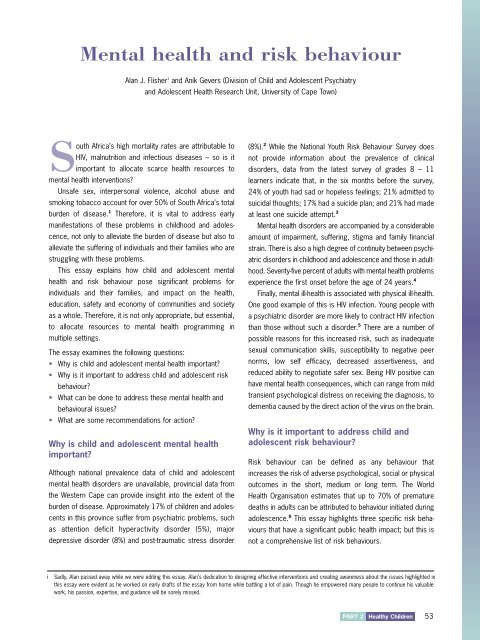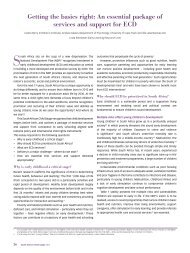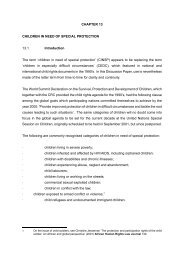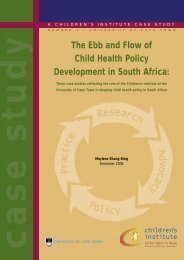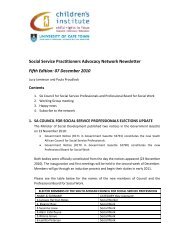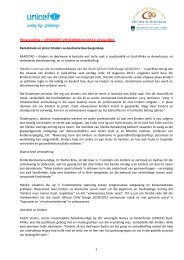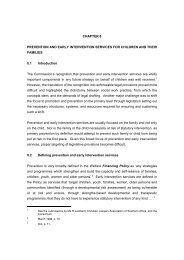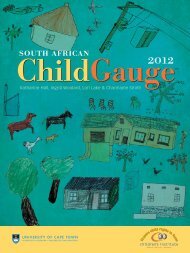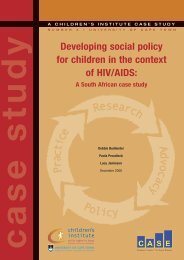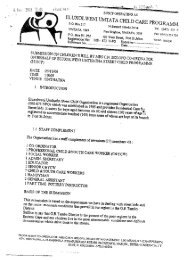Mental health and risk behaviour
Mental health and risk behaviour
Mental health and risk behaviour
Create successful ePaper yourself
Turn your PDF publications into a flip-book with our unique Google optimized e-Paper software.
<strong>Mental</strong> <strong>health</strong> <strong>and</strong> <strong>risk</strong> <strong>behaviour</strong><br />
Alan J. Flisher i <strong>and</strong> Aník Gevers (Division of Child <strong>and</strong> Adolescent Psychiatry<br />
<strong>and</strong> Adolescent Health Research Unit, University of Cape Town)<br />
South Africa’s high mortality rates are attributable to<br />
HIV, malnutrition <strong>and</strong> infectious diseases – so is it<br />
important to allocate scarce <strong>health</strong> resources to<br />
mental <strong>health</strong> interventions?<br />
Unsafe sex, interpersonal violence, alcohol abuse <strong>and</strong><br />
smoking tobacco account for over 50% of South Africa’s total<br />
burden of disease. 1 Therefore, it is vital to address early<br />
manifestations of these problems in childhood <strong>and</strong> adolescence,<br />
not only to alleviate the burden of disease but also to<br />
alleviate the suffering of individuals <strong>and</strong> their families who are<br />
struggling with these problems.<br />
This essay explains how child <strong>and</strong> adolescent mental<br />
<strong>health</strong> <strong>and</strong> <strong>risk</strong> <strong>behaviour</strong> pose significant problems for<br />
individuals <strong>and</strong> their families, <strong>and</strong> impact on the <strong>health</strong>,<br />
education, safety <strong>and</strong> economy of communities <strong>and</strong> society<br />
as a whole. Therefore, it is not only appropriate, but essential,<br />
to allocate resources to mental <strong>health</strong> programming in<br />
multiple settings.<br />
The essay examines the following questions:<br />
• Why is child <strong>and</strong> adolescent mental <strong>health</strong> important?<br />
• Why is it important to address child <strong>and</strong> adolescent <strong>risk</strong><br />
<strong>behaviour</strong>?<br />
• What can be done to address these mental <strong>health</strong> <strong>and</strong><br />
<strong>behaviour</strong>al issues?<br />
• What are some recommendations for action?<br />
Why is child <strong>and</strong> adolescent mental <strong>health</strong><br />
important?<br />
Although national prevalence data of child <strong>and</strong> adolescent<br />
mental <strong>health</strong> disorders are unavailable, provincial data from<br />
the Western Cape can provide insight into the extent of the<br />
burden of disease. Approximately 17% of children <strong>and</strong> adolescents<br />
in this province suffer from psychiatric problems, such<br />
as attention deficit hyperactivity disorder (5%), major<br />
depressive disorder (8%) <strong>and</strong> post-traumatic stress disorder<br />
(8%). 2 While the National Youth Risk Behaviour Survey does<br />
not provide information about the prevalence of clinical<br />
disorders, data from the latest survey of grades 8 – 11<br />
learners indicate that, in the six months before the survey,<br />
24% of youth had sad or hopeless feelings; 21% admitted to<br />
suicidal thoughts; 17% had a suicide plan; <strong>and</strong> 21% had made<br />
at least one suicide attempt. 3<br />
<strong>Mental</strong> <strong>health</strong> disorders are accompanied by a considerable<br />
amount of impairment, suffering, stigma <strong>and</strong> family financial<br />
strain. There is also a high degree of continuity between psychiatric<br />
disorders in childhood <strong>and</strong> adolescence <strong>and</strong> those in adulthood.<br />
Seventy-five percent of adults with mental <strong>health</strong> problems<br />
experience the first onset before the age of 24 years. 4<br />
Finally, mental ill-<strong>health</strong> is associated with physical ill-<strong>health</strong>.<br />
One good example of this is HIV infection. Young people with<br />
a psychiatric disorder are more likely to contract HIV infection<br />
than those without such a disorder. 5 There are a number of<br />
possible reasons for this increased <strong>risk</strong>, such as inadequate<br />
sexual communication skills, susceptibility to negative peer<br />
norms, low self efficacy, decreased assertiveness, <strong>and</strong><br />
reduced ability to negotiate safer sex. Being HIV positive can<br />
have mental <strong>health</strong> consequences, which can range from mild<br />
transient psychological distress on receiving the diagnosis, to<br />
dementia caused by the direct action of the virus on the brain.<br />
Why is it important to address child <strong>and</strong><br />
adolescent <strong>risk</strong> <strong>behaviour</strong>?<br />
Risk <strong>behaviour</strong> can be defined as any <strong>behaviour</strong> that<br />
increases the <strong>risk</strong> of adverse psychological, social or physical<br />
outcomes in the short, medium or long term. The World<br />
Health Organisation estimates that up to 70% of premature<br />
deaths in adults can be attributed to <strong>behaviour</strong> initiated during<br />
adolescence. 6 This essay highlights three specific <strong>risk</strong> <strong>behaviour</strong>s<br />
that have a significant public <strong>health</strong> impact; but this is<br />
not a comprehensive list of <strong>risk</strong> <strong>behaviour</strong>s.<br />
i Sadly, Alan passed away while we were editing this essay. Alan’s dedication to designing effective interventions <strong>and</strong> creating awareness about the issues highlighted in<br />
this essay were evident as he worked on early drafts of the essay from home while battling a lot of pain. Though he empowered many people to continue his valuable<br />
work, his passion, expertise, <strong>and</strong> guidance will be sorely missed.<br />
PART 2 Healthy Children<br />
53
Table 7: Prevalence of substance use among school children in Cape Town <strong>and</strong> South Africa<br />
Substance use<br />
Cape Town # South Africa +<br />
Girls Boys Girls <strong>and</strong> boys<br />
% % %<br />
Cigarettes (in the month prior to the study) 25.8 33.1 21<br />
Alcohol (in the month prior to the study) 24.5 32.1 35<br />
Cannabis (in the month prior to the study) 8.7 21.1 10<br />
Methamphetamine – ‘tik’ (ever) 11.9 13.3 –<br />
M<strong>and</strong>rax (ever) – – 7<br />
Cocaine (ever) – – 7<br />
Heroin (ever) – – 6<br />
Sources:<br />
# Plüddemann A, Flisher AJ, Mathews C, Carney T & Lombard C (2008) Adolescent methamphetamine use <strong>and</strong> sexual <strong>risk</strong> <strong>behaviour</strong> in secondary school students<br />
in Cape Town, South Africa. Drug <strong>and</strong> Alcohol Review, 29: 1-6.<br />
+ Reddy SP, James S, Sewpail R, Koopman F, Funani NI, Sifunda S, Josie J, Masuka P, Kambaran NS & Omardien RG (2010) Umthente Uhlaba Usamila – The South<br />
African Youth Behavioural Survey 2008. Cape Town: Medical Research Council.<br />
Sexual <strong>risk</strong> <strong>behaviour</strong><br />
According to the National Youth Risk Behaviour Survey, 38%<br />
of South Africa’s youth have had sex, with 13% reporting<br />
being under the age of 14 years at sexual debut. 7 There is<br />
considerable evidence that rates of sexual <strong>risk</strong> <strong>behaviour</strong> are<br />
high. According to the Human Sciences Research Council<br />
(HSRC), 8.5% of 15 – 24-year-olds reported having had sex<br />
before the age of 15 years; 14.5% had a partner who was<br />
more than five years older than themselves; <strong>and</strong> 30.8% of<br />
males aged 15 – 24 years had more than one sexual partner<br />
in the 12 months prior to the study. 8<br />
Among sexually active grades 8 – 11 learners, 41% reported<br />
more than two sexual partners in their lifetime <strong>and</strong> 52%<br />
reported more than one sexual partner in the three months<br />
before the survey. 9 In addition, 12% of these learners reported<br />
using alcohol or drugs before having sex. While these <strong>behaviour</strong>s<br />
are certainly cause for concern, young people also<br />
seem to engage in <strong>health</strong>y sexual <strong>behaviour</strong>s. For example,<br />
rates of condom use were high among the youth responding<br />
to the HSRC study, where 87.4% of males <strong>and</strong> 73.1% of<br />
females reported using a condom at last sex. 10<br />
Substance use<br />
Table 7 presents substance use data from a Cape Town study<br />
(a representative sample of 4,605 grade 9 students at 15<br />
high schools) <strong>and</strong> from the National Youth Risk Behaviour<br />
Survey. A further study involving 1,561 grades 8 – 10 learners<br />
in Cape Town reported that those using crystal methamphetamine<br />
(‘tik’) had higher rates of aggression, depression <strong>and</strong><br />
generic mental <strong>health</strong> problems. 10<br />
Violence<br />
More data are available for interpersonal violence. Tables 8<br />
<strong>and</strong> 9 present data on prevalence of violent <strong>behaviour</strong> <strong>and</strong><br />
bullying in schools, indicating that South Africa’s youth are<br />
engaging in very high levels of violent <strong>behaviour</strong>. In addition, a<br />
study among grades 8 <strong>and</strong> 11 students in Cape Town about<br />
intimate partner violence indicated that 20.7% reported<br />
perpetrating partner violence <strong>and</strong> 16.4% reported intending to<br />
do so (measured by survey items asking whether the<br />
respondent would use violence against a partner in the future,<br />
specifically if the partner angered the respondent). 12<br />
High levels of violence also emerged in the National Youth<br />
Risk Behaviour Survey, where 10% of learners reported being<br />
forced to have sex <strong>and</strong> 9% admitted to forcing someone to<br />
have sex. In the previous month, 27% of learners reported<br />
feeling unsafe at school <strong>and</strong> 15% admitted to carrying a<br />
weapon; while 31% reported being in a physical fight <strong>and</strong> 19%<br />
reported being a member of a gang in the previous six<br />
months. 13<br />
Table 8: National prevalence data on violent <strong>behaviour</strong><br />
collected from 260 primary <strong>and</strong> high schools<br />
(number = 12,794)<br />
Behaviour Prevalence (%)<br />
Threatened at school 14.5<br />
Assaulted at school 4.3<br />
Robbed at school 5.9<br />
Sexual violence at school 3.1<br />
Source: Burton P (2008) Merchants, skollies <strong>and</strong> stones: Experiences of school<br />
violence in South Africa. Cape Town: Centre for Justice <strong>and</strong> Crime Prevention.<br />
54<br />
South African Child Gauge 2009/2010
Table 9: Prevalence of bullying among grades 8 <strong>and</strong> 11<br />
learners from Cape Town <strong>and</strong> Durban schools (number = 5,074)<br />
Behaviour Prevalence (%)<br />
Bully 8.2<br />
Victim 19.3<br />
Bully-victim 8.7<br />
Source: Liang H, Flisher AJ, Lombard CJ (2007) Bullying, violence, <strong>and</strong> <strong>risk</strong><br />
<strong>behaviour</strong> in South African school students. Child Abuse & Neglect, 31: 161-171.<br />
Associations between <strong>risk</strong> <strong>behaviour</strong>s<br />
Involvement in one <strong>risk</strong> <strong>behaviour</strong> increases the chances of<br />
involvement in other <strong>risk</strong> <strong>behaviour</strong>s. An earlier study among<br />
high school students in the Cape Peninsula found that, in comparison<br />
to learners who reported no <strong>risk</strong> <strong>behaviour</strong>, those who<br />
engaged in any one of the following <strong>risk</strong> <strong>behaviour</strong>s were more<br />
likely to engage in some of the others: cigarette smoking;<br />
sexual intercourse; going out at night beyond the neighbourhood<br />
<strong>and</strong> walking home alone; attempting suicide; using cannabis;<br />
not wearing a seat belt. 14 The existence of this co-variation<br />
between <strong>risk</strong> <strong>behaviour</strong>s has been confirmed in several subsequent<br />
studies. For example, adolescents who had used methamphetamine<br />
in the past 30 days were more likely to have engaged<br />
in vaginal, oral, <strong>and</strong> anal sex. 15 Thus, the <strong>health</strong> <strong>risk</strong>s associated<br />
with engaging in <strong>risk</strong> <strong>behaviour</strong>s are amplified by additional<br />
<strong>and</strong> simultaneous involvement in other <strong>risk</strong> <strong>behaviour</strong>s.<br />
FinalIy, there are strong grounds to conclude that mental<br />
ill-<strong>health</strong> <strong>and</strong> <strong>risk</strong> <strong>behaviour</strong> are associated with each other. A<br />
recent literature review identified 89 studies published between<br />
1990 <strong>and</strong> 2007 that reported an association between substance<br />
use <strong>and</strong> psychopathology among adolescents. 16 Similarly, a<br />
study among Cape Town high school students found that<br />
exposure to violence is associated with depression, anxiety<br />
<strong>and</strong> post-traumatic stress disorder. 17<br />
What can be done to address mental <strong>health</strong><br />
<strong>and</strong> <strong>behaviour</strong>al problems?<br />
Clinical services are perhaps the most obvious response to<br />
child <strong>and</strong> adolescent mental ill-<strong>health</strong> <strong>and</strong> <strong>risk</strong> <strong>behaviour</strong>.<br />
Traditionally these services have generally served a treatment<br />
or rehabilitative purpose. In support of this type of response,<br />
there is a large <strong>and</strong> growing body of evidence that many child<br />
<strong>and</strong> adolescent psychiatric disorders can be effectively treated<br />
using psychotherapy <strong>and</strong>/or psychotropic ii medication. 18 These<br />
specialised services are essential <strong>and</strong> need to be strengthened.<br />
However, mental <strong>health</strong> services for children <strong>and</strong> adolescents<br />
need to be broadened to include mental <strong>health</strong> promotion<br />
<strong>and</strong> primary prevention in order to support optimal development<br />
<strong>and</strong> well-being <strong>and</strong> to prevent the occurrence of mental<br />
<strong>health</strong> or <strong>risk</strong> <strong>behaviour</strong> problems. Interventions need to be<br />
integrated into multiple settings <strong>and</strong> remain consistent across<br />
individual, interpersonal, community, <strong>and</strong> socio-structural<br />
levels. 19 As mental ill-<strong>health</strong> is associated with physical ill<strong>health</strong><br />
<strong>and</strong> <strong>risk</strong> <strong>behaviour</strong>, this implies that interventions should<br />
be as comprehensive as possible. It is, for example, ill-advised<br />
to focus on an adolescent’s substance misuse without also<br />
addressing associated mood disorder or sexual <strong>risk</strong> <strong>behaviour</strong>.<br />
There is a need for a multi-pronged approach that supports<br />
the implementation of services for different groups of youth,<br />
<strong>and</strong> for various groups of people who are influential in young<br />
people’s lives. 20 Universal interventions are broad <strong>and</strong> provided<br />
to a general population (eg all pre-school children), whereas<br />
selected interventions provide services to particular groups<br />
(eg vulnerable or at-<strong>risk</strong> youth) or at critical stages of<br />
children’s development). Indicated interventions are services<br />
aimed at people who are struggling with particular mental<br />
<strong>health</strong> <strong>and</strong> <strong>behaviour</strong>al problems (eg youth with a psychiatric<br />
diagnosis). Parents, primary caregivers <strong>and</strong> youth service<br />
providers should also receive interventions that will support<br />
child <strong>and</strong> adolescent mental <strong>health</strong>. These interventions will<br />
strengthen the people <strong>and</strong> environments that are particularly<br />
influential in youth’s lives <strong>and</strong> well-being.<br />
Child <strong>and</strong> adolescent mental <strong>health</strong> care cannot only be<br />
confined to specialised mental <strong>health</strong> care settings. Indeed, a<br />
continuum of mental <strong>health</strong> services can <strong>and</strong> should be offered<br />
in various settings. This includes <strong>health</strong> promotion, prevention,<br />
treatment <strong>and</strong> rehabilitation services at primary <strong>health</strong> care<br />
clinics, schools, youth <strong>and</strong> community centres, faith-based<br />
centres, non-governmental organisations (NGOs), media outlets<br />
<strong>and</strong> homes. For example, the Healthwise programme described<br />
in case 2 on the next page implements a <strong>health</strong> promotion <strong>and</strong><br />
primary prevention programme in schools <strong>and</strong> communities.<br />
Consistent messaging <strong>and</strong> support across these domains will<br />
ensure that youth are fully supported in their mental <strong>health</strong> <strong>and</strong><br />
development <strong>and</strong> that problems are either prevented or<br />
detected early for intervention.<br />
Interventions also need to address the economic <strong>and</strong><br />
socio-cultural factors that continue to exacerbate mental<br />
<strong>health</strong> disorders <strong>and</strong> <strong>risk</strong> <strong>behaviour</strong>. For example, the culture<br />
of violence in South African society not only contributes to<br />
individual distress, but it also supports continued violent<br />
ii Psychotropic medication is any pharmaceutical used primarily in the treatment of mental illnesses to improve emotional, perceptual, or <strong>behaviour</strong>al symptoms of these<br />
illnesses through their action on brain functioning.<br />
PART 2 Healthy Children<br />
55
ehaviour among children <strong>and</strong> adolescents. Exposure to corporal<br />
punishment, domestic violence, <strong>and</strong> community violence<br />
gives youth the message that violent <strong>behaviour</strong> is a normal<br />
response, particularly in conflict or discipline situations. Young<br />
people will only learn that violent <strong>behaviour</strong> is unacceptable<br />
when society stops condoning such violent <strong>behaviour</strong> <strong>and</strong> starts<br />
promoting pro-social <strong>behaviour</strong>, for example, by equipping<br />
parents <strong>and</strong> teachers with positive discipline strategies <strong>and</strong><br />
enforcing non-violent policies <strong>and</strong> legislation (such as the<br />
South African Schools Act 21 ).<br />
Interventions do not need to be limited to workshop or<br />
traditional therapy formats. Indeed, creative ways to address<br />
mental <strong>health</strong> <strong>and</strong> <strong>risk</strong> <strong>behaviour</strong> among youth across traditional<br />
<strong>and</strong> non-traditional fields are essential. Below are some suggestions<br />
to help various role-players to begin thinking about actions<br />
they can take as individuals in their professional or personal<br />
capacity.<br />
What are some recommendations<br />
for action?<br />
Case 2: The Healthwise intervention<br />
The Healthwise intervention seeks to reduce <strong>risk</strong> <strong>behaviour</strong>s<br />
in youth by delivering the programme in lifeorientation<br />
classes in schools <strong>and</strong> various complementary,<br />
<strong>health</strong> promoting activities in communities.<br />
These activities focus on providing youth with opportunities<br />
to engage in positive <strong>behaviour</strong>s during leisure time,<br />
such as community service activities or playing games<br />
with friends in safe environments. Youth learn <strong>and</strong> practice<br />
various skills to aid them to make decisions,<br />
regulate their emotions, resolve conflict, <strong>and</strong> overcome<br />
boredom in <strong>health</strong>y ways.<br />
This programme was developed, monitored <strong>and</strong><br />
evaluated with a multi-disciplinary team in the Western<br />
Cape in conjunction with collaborators in Pennsylvania,<br />
USA. Initial results from a study assessing the impact of<br />
the programme in Cape Town schools indicate positive<br />
effects of the intervention, but a full report is awaited<br />
before recommendations to scale up the programme<br />
can be made.<br />
Source: Caldwell L, Smith E, Wegner L, Vergnani T, Mpofu E, Flisher AJ &<br />
Mathews C (2004) HealthWise South Africa: Development of a life skills curriculum<br />
for young adults. World Leisure, 3: 4-17.<br />
It is important that all role-players stay informed of developments<br />
in child <strong>and</strong> adolescent mental <strong>health</strong> <strong>and</strong> participate in<br />
continuous training. Just as important are building connections<br />
<strong>and</strong> partnerships to co-ordinate efforts to support child<br />
<strong>and</strong> adolescent mental <strong>health</strong>, <strong>and</strong> to improve mental <strong>health</strong><br />
services. The following recommendations outline how people<br />
from different groups can support child <strong>and</strong> adolescent mental<br />
<strong>health</strong>. Risk <strong>behaviour</strong> is conceptualised as a component of<br />
child <strong>and</strong> adolescent mental <strong>health</strong>, thus any mention of<br />
mental <strong>health</strong> interventions includes interventions that target<br />
sexual <strong>behaviour</strong>, substance use, <strong>and</strong> violent <strong>behaviour</strong>.<br />
<strong>Mental</strong> <strong>health</strong> professionals<br />
• Stay informed about developments in child <strong>and</strong> adolescent<br />
mental <strong>health</strong> interventions <strong>and</strong> continuously monitor <strong>and</strong><br />
evaluate interventions <strong>and</strong> programmes that are being<br />
implemented.<br />
• Integrate <strong>health</strong> promotion <strong>and</strong> illness prevention into treatment<br />
<strong>and</strong> rehabilitation services.<br />
• Engage other key stakeholders <strong>and</strong> provide guidance on<br />
how to strengthen their roles in child <strong>and</strong> adolescent mental<br />
<strong>health</strong> interventions.<br />
Other <strong>health</strong> care <strong>and</strong> social service professionals<br />
• Integrate mental <strong>health</strong> screening into primary <strong>health</strong> care<br />
services.<br />
• Integrate basic mental <strong>health</strong> promotion <strong>and</strong> illness prevention<br />
interventions.<br />
• Liaise with mental <strong>health</strong> care professionals in providing<br />
comprehensive treatment to patients <strong>and</strong> make referrals<br />
for specialised care when appropriate.<br />
Parents <strong>and</strong> primary caregivers<br />
• Use positive parenting skills (eg positive reinforcement,<br />
<strong>behaviour</strong>al modification) <strong>and</strong> build strong family relationships<br />
to support a child’s development.<br />
• Take care of own mental <strong>health</strong> as this will help with parenting<br />
<strong>and</strong> provide a good role model for the child.<br />
• Seek help from social services, counsellors, or <strong>health</strong> care<br />
providers when concerned about a child <strong>and</strong> find out what<br />
can be done to support the child <strong>and</strong> the rest of the family.<br />
Teachers <strong>and</strong> school administrators <strong>and</strong> youth leaders<br />
• Build partnerships with NGOs, social services, community<br />
leaders, other schools, researchers, <strong>and</strong> mental <strong>health</strong> care<br />
professionals to create a <strong>health</strong> promoting environment at<br />
school.<br />
• Underst<strong>and</strong> how to detect <strong>and</strong> deal with or refer children or<br />
adolescents who are struggling with mental <strong>health</strong>, <strong>behaviour</strong>al,<br />
<strong>and</strong>/or academic problems.<br />
• Integrate universal mental <strong>health</strong> promotion <strong>and</strong> illness<br />
prevention programmes into school activities such as life-<br />
56<br />
South African Child Gauge 2009/2010
orientation classes, school assemblies, extra-curricular<br />
clubs <strong>and</strong> other classes in the academic programme.<br />
• Establish a wellness committee of staff <strong>and</strong> students who<br />
organise mental <strong>health</strong> promotion campaigns for the<br />
school community.<br />
• Provide supportive services to youth who are struggling or<br />
have recently overcome mental <strong>health</strong> challenges.<br />
Activists <strong>and</strong> advocates<br />
• Create awareness about child <strong>and</strong> adolescent mental <strong>health</strong><br />
<strong>and</strong> the need to integrate interventions at multiple levels.<br />
• Advocate for the implementation of child <strong>and</strong> adolescentfriendly<br />
policies.<br />
• Develop poster campaigns <strong>and</strong> self-help booklets with<br />
information, resources <strong>and</strong> activities that address pertinent<br />
youth mental <strong>health</strong> <strong>and</strong> <strong>risk</strong> <strong>behaviour</strong>.<br />
Researchers<br />
• Develop <strong>and</strong> evaluate programmes for a variety of settings<br />
<strong>and</strong> mental <strong>health</strong> issues along the full continuum of services.<br />
• Disseminate information about child <strong>and</strong> adolescent mental<br />
<strong>health</strong> in accessible ways to all levels of stakeholders.<br />
• Liaise <strong>and</strong> partner with multi-disciplinary service providers<br />
on the development, evaluation <strong>and</strong> dissemination of effective<br />
interventions <strong>and</strong> associated training.<br />
Corporate entities, publishers <strong>and</strong> mainstream media<br />
• Display brochures, magazines <strong>and</strong> adverts that promote<br />
child <strong>and</strong> adolescent mental <strong>health</strong> <strong>and</strong> suggest resources<br />
for difficulties with mental disorders or <strong>risk</strong> <strong>behaviour</strong>.<br />
• Provide funding for child <strong>and</strong> adolescent mental <strong>health</strong><br />
campaigns <strong>and</strong> interventions.<br />
• Run advertising campaigns, develop self-help resources or<br />
publish stories or articles that address mental <strong>health</strong> <strong>and</strong> <strong>risk</strong><br />
<strong>behaviour</strong>, <strong>and</strong> provide positive role models for children,<br />
adolescents, parents <strong>and</strong> teachers.<br />
Policy-makers <strong>and</strong> legislators<br />
• Integrate child <strong>and</strong> adolescent-friendly m<strong>and</strong>ates <strong>and</strong><br />
policies that support interventions in multiple settings <strong>and</strong><br />
at individual, interpersonal, community <strong>and</strong> socio-cultural<br />
levels.<br />
• Allocate resources for training, staff support, service<br />
delivery, monitoring <strong>and</strong> evaluation of evidence-based interventions<br />
along the full continuum of services for child <strong>and</strong><br />
adolescent mental <strong>health</strong>.<br />
• Develop a strategic plan that co-ordinates interventions.<br />
References<br />
1 Norman R, Bradshaw D, Schneider M, Joubert J, Groenewald P & Lewin S<br />
(2007) A comparative <strong>risk</strong> assessment for South Africa in 2000: Towards<br />
promoting <strong>health</strong> <strong>and</strong> preventing disease. South African Medical Journal, 97:<br />
637-641.<br />
2 Kleintjies S, Flisher AJ, Fick M, Railon A, Lund C, Molteno C & Robertson BA<br />
(2006) The prevalence of mental disorders among children, adolescents<br />
<strong>and</strong> adults in the Western Cape, South Africa. South African Psychiatry<br />
Review, 9: 157-160.<br />
3 Reddy SP, James S, Sewpail R, Koopman F, Funani NI, Sifunda S, Josie J,<br />
Masuka P, Kambaran NS & Omardien RG (2010) Umthente Uhlaba Usamila –<br />
The South African Youth Behavioural Survey 2008. Cape Town: Medical<br />
Research Council.<br />
4 Kessler R, Bergl<strong>and</strong> P, Demler O, Jin R, Koretz D, Merikangas KR, Rush AJ,<br />
Walters EE & Wang PS (2003) The epidemiology of major depressive<br />
disorder: Results from the National Comorbidity Survey Replication (NCS-R).<br />
Journal of the American Medical Association, 289: 3095-3105.<br />
5 Patel V, Flisher AJ, Hertick S & McGorry P (2007) The mental <strong>health</strong> of young<br />
people: A global public <strong>health</strong> challenge. The Lancet, 369: 1302-1313.<br />
6 World Health Organisation (2001) The second decade: Improving adolescent<br />
<strong>health</strong> <strong>and</strong> development. Geneva: WHO.<br />
7 See no. 3 above.<br />
8 Flisher AJ & Gevers A (2010) Adolescence. In: Petersen I, Bhana A, Flisher AJ,<br />
Swartz L & Richter L (eds) Promoting mental <strong>health</strong> in scarce-resource<br />
contexts: Emerging evidence <strong>and</strong> practice. Cape Town: HSRC Press.<br />
9 See no. 3 above.<br />
10 See no. 8 above.<br />
11 Plüddemann A, Flisher AJ, McKetin R, Parry C & Lombard C (in press)<br />
Methamphetamine use, aggressive behavior <strong>and</strong> other mental <strong>health</strong> issues<br />
among high school students in Cape Town, South Africa. Drug <strong>and</strong> Alcohol<br />
Dependence (forthcoming).<br />
12 Flisher AJ, Myer L, Marais A, Lombard C & Reddy P (2007) Prevalence <strong>and</strong><br />
correlates of partner violence among South African adolescents. Journal of<br />
Child Psychology <strong>and</strong> Psychiatry, 48: 619-627.<br />
13 See no. 3 above.<br />
14 Flisher AJ, Kramer RA, Hoven CW, King RA, Bird HR, Davies M, Gould MS,<br />
Greenwald S, Lahey BB, Regier DA, Schwab-Stone M & Shaffer D (2000)<br />
Risk <strong>behaviour</strong> in a community sample of children <strong>and</strong> adolescents. Journal<br />
of the American Academy of Child & Adolescent Psychiatry, 39: 881-887.<br />
15 Plüddemann A, Flisher AJ, Mathews C, Carney T & Lombard C (2008) Adolescent<br />
methamphetamine use <strong>and</strong> sexual <strong>risk</strong> <strong>behaviour</strong> in secondary school<br />
students in Cape Town, South Africa. Drug <strong>and</strong> Alcohol Review, 29: 1-6.<br />
16 Saban A & Flisher AJ (in press) The association between psychopathology <strong>and</strong><br />
substance use in young people: A review of the literature. Journal of<br />
Psychoactive Drugs (forthcoming).<br />
17 Flisher AJ, Ward CL, Liang H, Onya H, Mlisa N, Terblanche S, Bhana A, Parry<br />
CDH & Lombard CJ (2006) Injury-related <strong>behaviour</strong> among South African<br />
high-school students at six sites. South African Medical Journal, 96: 825-830.<br />
18 Brown RT & La Rosa A (2002) Recent developments in the pharmacotherapy<br />
of attention-deficit/hyperactivity disorder (ADHD). Professional Psychology:<br />
Research <strong>and</strong> Practice, 33: 591-595;<br />
Harrington R, Whittaker J & Shoebridge P (1998) Psychological treatment<br />
of depression in children <strong>and</strong> adolescents: A review of treatment research.<br />
British Journal of Psychiatry, 173: 291-298;<br />
The TADS Team (2007) The treatment for adolescents with depression study<br />
(TADS): Long-term effectiveness <strong>and</strong> safety outcomes. Archives of General<br />
Psychiatry, 64: 1132-1144.<br />
19 See no. 9 above.<br />
20 Patel V, Flisher AJ, Nikapota A & Malhotra S (2008) Promoting child <strong>and</strong> adolescent<br />
mental <strong>health</strong> in low <strong>and</strong> middle income countries. Journal of Child<br />
Psychology <strong>and</strong> Psychiatry, 49: 313-334.<br />
21 South African Schools Act 84 of 1996.<br />
PART 2 Healthy Children<br />
57


